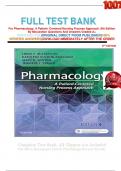Examen
FULL TEST BANK For Pharmacology: A Patient- Centered Nursing Process Approach, 9th Edition By Mccuistion Questions And Answers Graded A+
- Grado
- Institución
- Book
FULL TEST BANK For Pharmacology: A Patient- Centered Nursing Process Approach, 9th Edition By Mccuistion Questions And Answers Graded A+
[Mostrar más]



